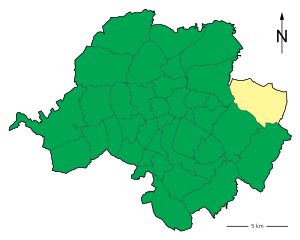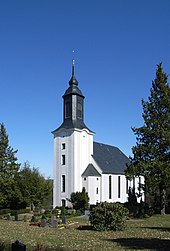Chemnitz-Euba
|
Euba district and statistical district No. 16 of Chemnitz |
|
|---|---|
| Coordinates | 50 ° 50 '15 " N , 13 ° 1' 30" E |
| surface | 11.74 km² |
| Residents | 1985 (Dec. 31, 2013) |
| Population density | 169 inhabitants / km² |
| Incorporation | March 1, 1994 |
| Post Code | 09128 |
| prefix | 03726 |
| Transport links | |
| bus | 83, 86 |
Euba is a district of the independent city of Chemnitz in Saxony . It was incorporated on March 1, 1994, making it the first Chemnitz district to be incorporated after reunification.
geography
Geographical location
Euba is located in the east of the city of Chemnitz on the Eubaer Bach . The place has kept its village character to this day. The highest elevations are the Galgenberg (472.7 m) and the Katzenberg (471.4 m). Euba is bordered by the “Struth”, “Black” and “ Zeisigwald ” forests . The best-known building in Euba is the Euba dam in the southwestern district.
Neighboring places
The Chemnitz districts of Hilbersdorf , Adelsberg and Kleinolbersdorf-Altenhain as well as the city of Flöha , the Oberwiesa district of the Niederwiesa municipality and the Erdmannsdorf district of the city of Augustusburg border on Euba .
history
The forest hoof village Euba, probably founded at the end of the 12th century, was first mentioned in a document in 1250 as "Iwen" in the Meissen diocese articles . At that time the village belonged to the rule of the " Lords of Waldenburg ". Euba was a medieval manor house from an early age . This was first mentioned in 1317 with "Ullrich von Ywan" and "Heinrich de Jwe" when "Ullrich von Ywan" sold the forest of Altenhain that belonged to him to the Chemnitz monastery . A moated castle served the feudal owner in Euba as his residence. It was probably located at the location of today's village pond. The feudal estate owned the jurisdiction as well as the brewing and serving rights. At that time, Euba was liable to the archdeaconate of Zschillen . After Euba came under the rule of the Wettins through the " Schellenberger Feud " in 1323 , it was presumably already an official village , at the latest by the end of the 16th century it was subordinate to the Electoral Saxon Office of Schellenberg, which was called Office Augustusburg from 1590 as a result of the construction of the Augustusburg hunting lodge . In the 16th century, the lords of Staupnitz, von Wesewitz (Wesenick), von Reinsberg and von Klettewitz lived on the fiefdom of Euba. After two fires in 1684 and 1856, the Euba fiefdom was rebuilt. After the feudal estate belonged to the Saxon sovereigns in the 18th century and was loaned to various state officials, it came into private ownership in the early 19th century, when the feudal estate was abolished.
In the late 16th century in the lower district Eubas were gold - soaps operated. In 1597 there were the 3 unions (prospecting sites) "Grube Goldener Löwe" at Grundbach (Niederdorf), "Goldenes Horn" at Fuchsgrund and "Goldenes Schwert" at Hahnebach. Euba was not spared from the chaos of the Hussite War , the Schmalkaldic War and the Thirty Years' War . The plague also raged in the village in 1633. In the 18th century, the people of Euba not only worked in the nearby quarries of the Zeisigwald , but until 1870 also removed slate from the local slate on the Wachtelberg and the Bergeshöh . In the 19th century, linen weavers and hosiery workers settled in Euba. This branch of business did not flourish due to the lack of sales in Chemnitz and the increasing competition.
Until 1856, Euba belonged to the Electoral Saxon or Royal Saxon Office of Augustusburg. After the end of the Saxon constitution of offices in 1856, Euba was under the jurisdiction of the court office of Augustusburg and, from 1875, of the administrative authority of Chemnitz . The Lehngut Euba was bought by the city of Chemnitz in 1928 and used as a municipal estate. The expropriation in the course of the land reform in the Soviet occupation zone from 1945 was reversed in 1948.
As a result of the second district reform in the GDR , the municipality of Euba came to the Chemnitz-Land district in the Chemnitz district (renamed the Karl-Marx-Stadt-Land district and the Karl-Marx-Stadt district in 1953 ), which from 1990 became the Saxon district of Chemnitz was continued. Euba was born on March 1, 1994, d. H. five months before the dissolution of the Chemnitz district, incorporated into the independent city of Chemnitz.
Euba dam
The dam , built between 1912 and 1914, served as a water reservoir for the Deutsche Reichsbahn . Underground pipelines transported the water to the Hilbersdorf railway depot. The dam is 14 m high and 180 m long. From the 1950s on, the reservoir was used as a natural swimming pool, which had to be closed in the 1980s due to its dilapidation. The association Rettet die Dalsperre Euba! Founded in October 2008! eV has set itself the goal of saving the Euba dam, which has been neglected for a long time, from impending deterioration and making it available again as a recreational facility for the residents of the community of Euba, the city of Chemnitz and the surrounding communities.
partnership
On October 2, 1990, the then still independent municipality of Euba signed a partnership with Schwanau in order to support the establishment of an independent administration and to underline the ties between the two German states. This partnership continues despite the incorporation into Chemnitz.
traffic
The CVAG bus line 86 runs along Eubaer Strasse , which runs from west to east, from Gablenzplatz in Chemnitz to the town center and then further north on the main road to Oberwiesa and Niederwiesa. The “Beutenberg-Häuser”, “Neueuba” and “Anton-Günther-Siedlung” settlement areas on the western edge of the Weißen Weg are served by bus route 89. The plan is to expand the southern network east of these settlements from Augustusburger Strasse to Dresdner and Frankenberger Strasse .
See also
literature
- The middle Zschopau area (= values of our homeland . Volume 28). 1st edition. Akademie Verlag, Berlin 1977, pp. 56-58.
- Richard Steche : Euba. In: Descriptive representation of the older architectural and art monuments of the Kingdom of Saxony. 7th issue: Amtshauptmannschaft Chemnitz . CC Meinhold, Dresden 1886, p. 40.
- Euba . In: August Schumann : Complete State, Post and Newspaper Lexicon of Saxony. 2nd volume. Schumann, Zwickau 1815, pp. 575-577.
- The district of Chemnitz in historical views , Geiger Verlag Horb am Neckar, 1992, ISBN 3-89264-730-5 (on the history of Euba: pp. 92–93)
Web links
- Euba on the Internet - Private Homepage
- Save the dam Euba eV
- Euba in the Digital Historical Directory of Saxony
Individual evidence
- ^ Karlheinz Blaschke , Uwe Ulrich Jäschke : Kursächsischer Ämteratlas. Leipzig 2009, ISBN 978-3-937386-14-0 ; P. 70 f.
- ^ The administrative authority of Chemnitz in the municipal directory 1900
- ↑ The Lehngut Euba on www.sachsens-schlösser.de
- ↑ Euba on gov.genealogy.net



